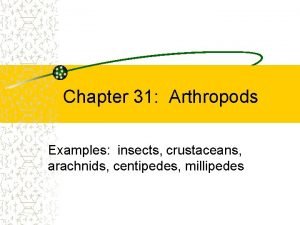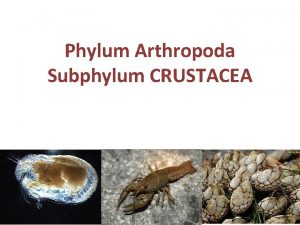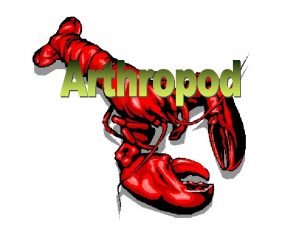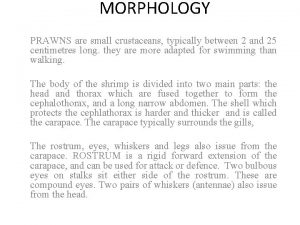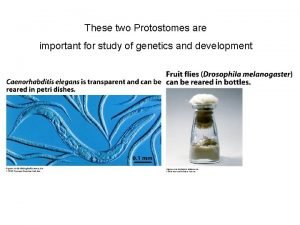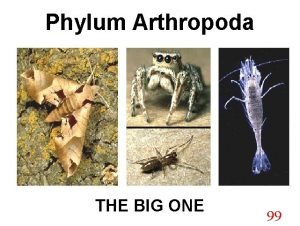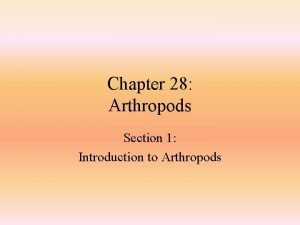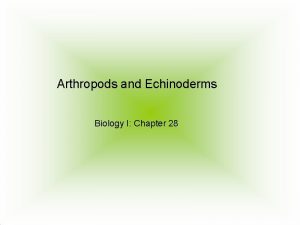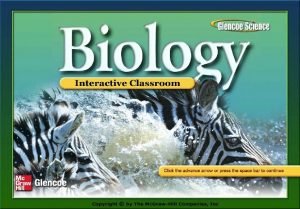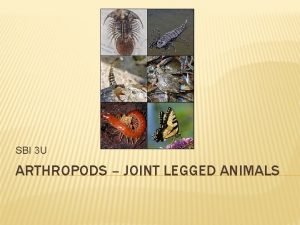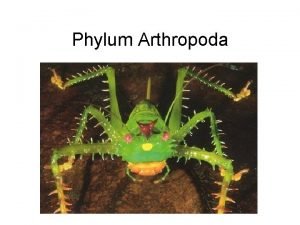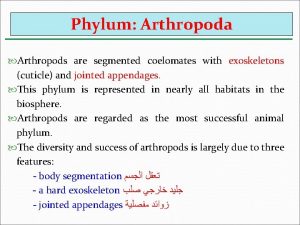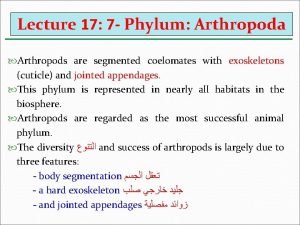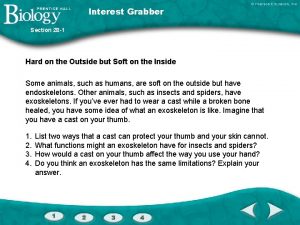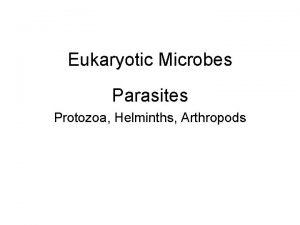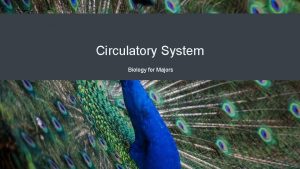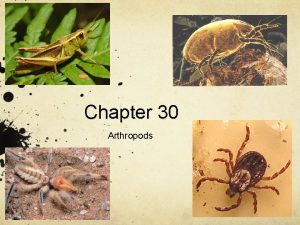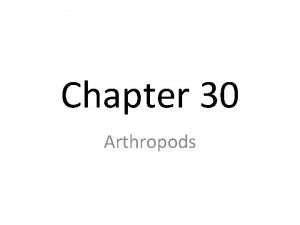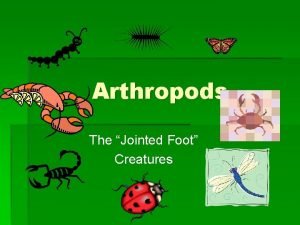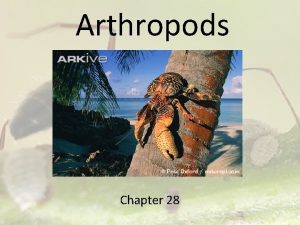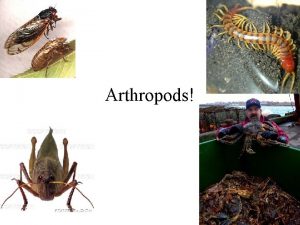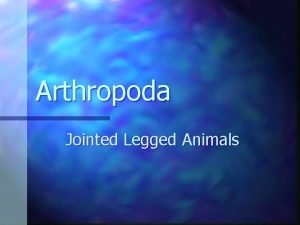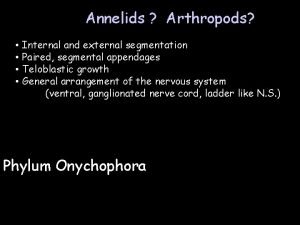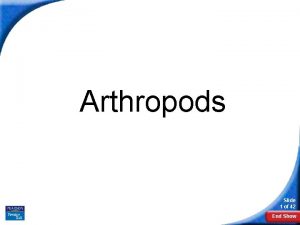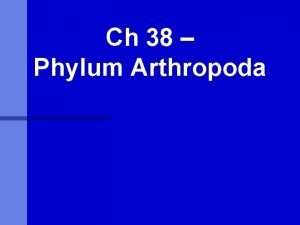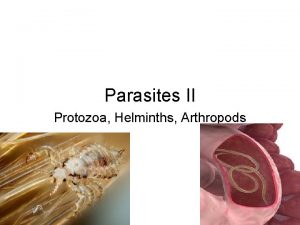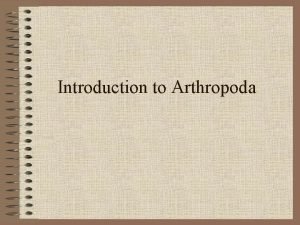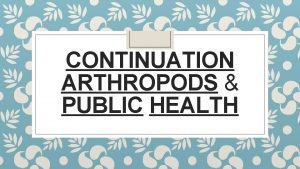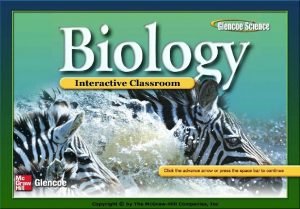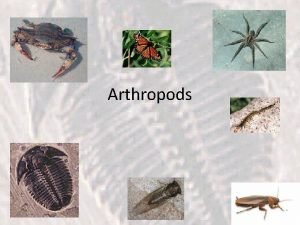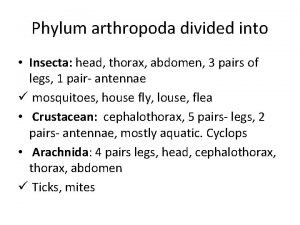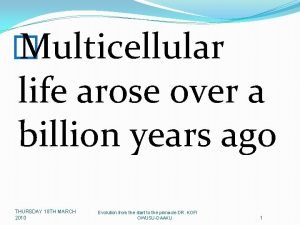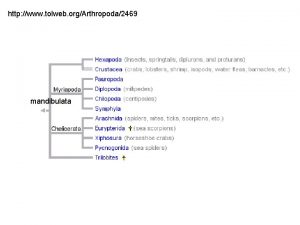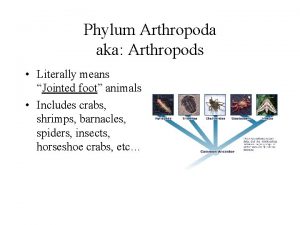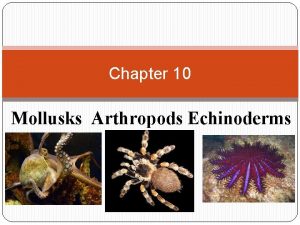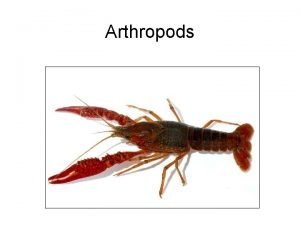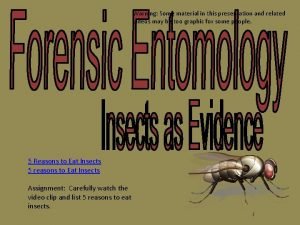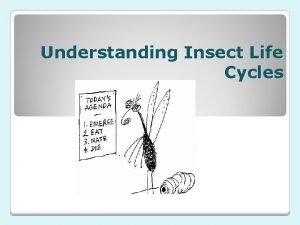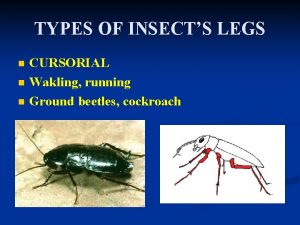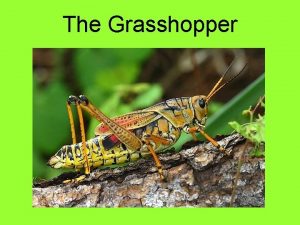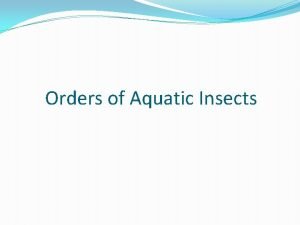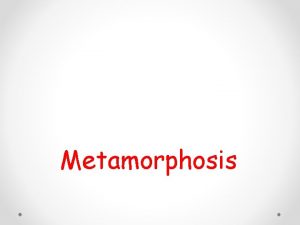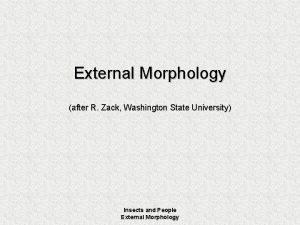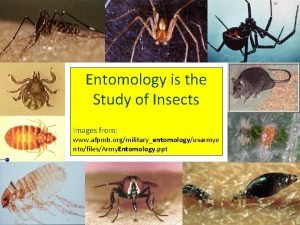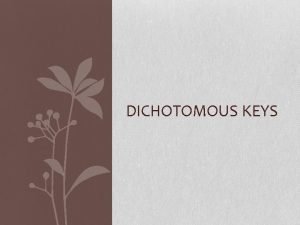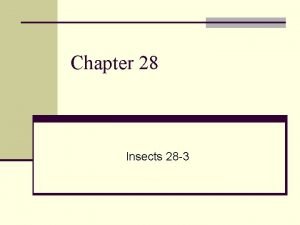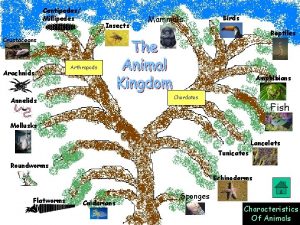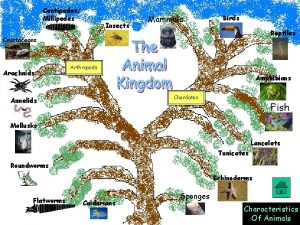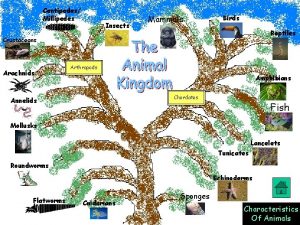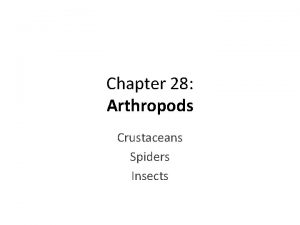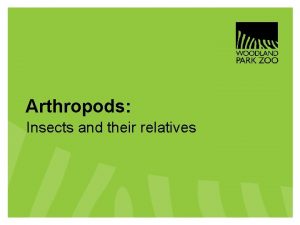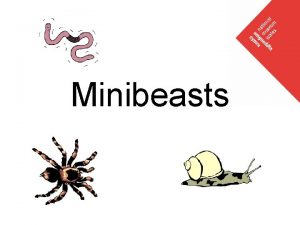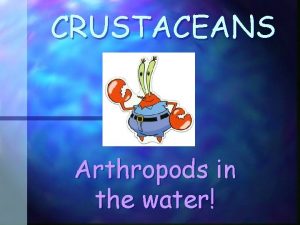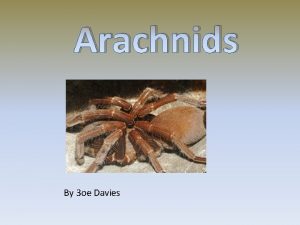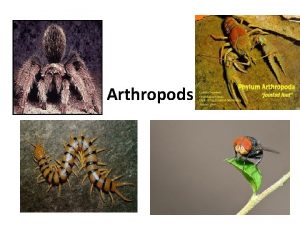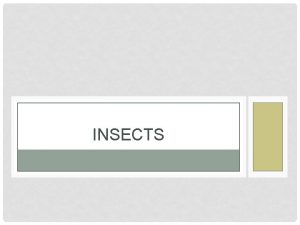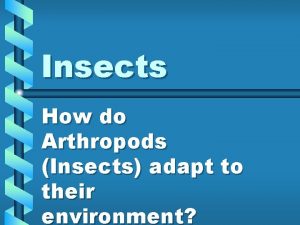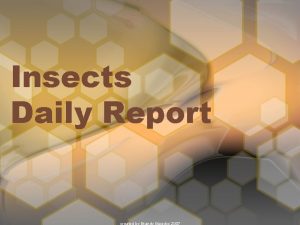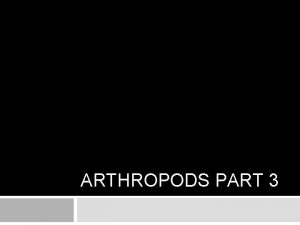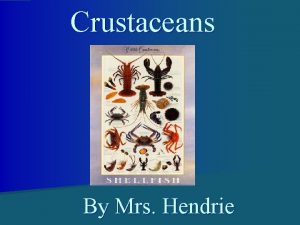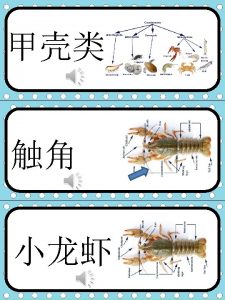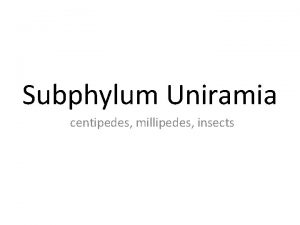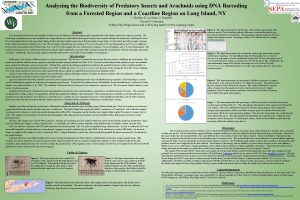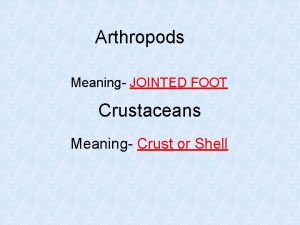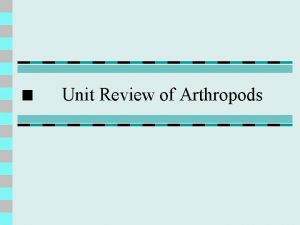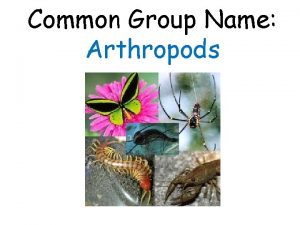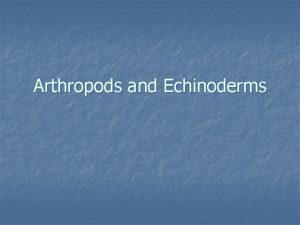Chapter 31 Arthropods Examples insects crustaceans arachnids centipedes




















































- Slides: 52

Chapter 31: Arthropods Examples: insects, crustaceans, arachnids, centipedes, millipedes

Most diverse phylum

Features of Arthropods “Jointed” appendages Segmented body: head, thorax, abdomen, cephalothoraxes – fused head and thorax – (arachnids)

Eyes of Arthropods Compound eyes – eye with many units Simple eyes – Single lens, see light and dark only, not image

Exoskeleton Made of chitin Purpose: Molting – shedding exoskeleton


Respiration Varies from group to group. Examples: trachea with spiracles Gills (aquatic) Book lungs (arachnids)


Open Circulatory System

Excretory System Malpighian tubules – sort of like our kidneys. Structures that filter blood.

I. Arachnids-unique characteristics Examples: spiders, scorpions, ticks, daddy long legs Eight legs 2 body segments: cephalothorax, abdomen Chelicerae – fangs Breath by using book lungs or tracheal tubes

Unique Feeding of Spiders can bite All have venom Spin web for capture

Brown Recluse

Brown Recluse

Wolf Spider

Tarantula


Camel spider


Scorpions Poisonous Stinger, Nocturnal

Household Dust mite

II. Insects Largest group on earth 3 Body sections: – Head – mouthparts, antennae – Thorax- 3 pairs of legs – abdomen – spiraclesorgans for breathing, open to tracheal tubes

Insect life cycle Metamorphosis – physical change Two types – complete and incomplete Complete – – 1. Larva – 2. Chrysalis- cocoon – 3. Pupa – inside cocoons – 4. Adult

Pupa stage with chrysalis

Adult stage

Incomplete Metamorphosis Less of a change 1. Egg 2. Nymph – a smaller version of the adult with no wings 3. Adult

Success of Insects Found everywhere Short life span, adapt to change quickly Flight – Elaborate social systems


Head Lice

III. Crustaceans Examples: crayfish, lobsters, pill bugs, crabs, barnacles Use gills

IV: Millipedes and centipedes -1 Pair of legs per segment -2 pair of legs per segment -Painful bite -Herbivores


Ch. 32 Echinoderms

Features of Echinoderms Spiny, marine invertebrates Endoskeleton – purpose is for protection, muscle attachment – Ossicles with spines Begin as bilateral, free-swimming larvae

Features of Echinoderms Radial symmetry as an adult

Water Vascular System of canals Used for locomotion, feeding and gas exchange Water flow through canals: – – Madreporite Ring canal Radial canals Tube feet – used for locomotion



Ventral surface of sea star





Additional Characteristics Nervous system: ring of nerves, eyespots Ability to regenerate Diet – hetertrophs: corals, worms, mollusks Some are herbivores



Wrap up Echinoderms Seastars Brittle stars Sea urchins Feather Stars

Group 1: Sea Stars

Brittle Stars Highly flexible arms, no anus, also feet on detritus – bottom dweller, regeneration

Feather Stars Not sessile, but like to be, sticky arms, nocturnal

Sea Cucumbers Regeneration of organs, tube feet

Sea Urchins Scrape algae off of rocks, sponges, tube feet
 Examples of centipedes
Examples of centipedes Sub phylum
Sub phylum Closed circulatory system
Closed circulatory system Dressed fish market form
Dressed fish market form Reproductive system of shrimp
Reproductive system of shrimp Protostomes are
Protostomes are Are crustaceans bugs
Are crustaceans bugs Section 28-1 introduction to the arthropods answer key
Section 28-1 introduction to the arthropods answer key Horseshoe crab respires through lungs.
Horseshoe crab respires through lungs. Chapter 26 section 3 insects and their relatives
Chapter 26 section 3 insects and their relatives Joint legged animals
Joint legged animals Subphylum
Subphylum Nervous system of arthropods
Nervous system of arthropods Segmented coelomates
Segmented coelomates Arthropods segmentation
Arthropods segmentation Section 28-3 insects
Section 28-3 insects Summary of hygiene
Summary of hygiene Parasitic arthropods
Parasitic arthropods Arthropods circulatory system
Arthropods circulatory system Arthropods segmentation
Arthropods segmentation Characteristics of arthropods
Characteristics of arthropods Arthropods characteristics
Arthropods characteristics Have segmented bodies
Have segmented bodies Characteristics of arthropods
Characteristics of arthropods What do arthropods have in common
What do arthropods have in common Joint legged animals
Joint legged animals Segmentation in arthropods
Segmentation in arthropods Section 28-1 introduction to the arthropods
Section 28-1 introduction to the arthropods Arthropoda characteristics
Arthropoda characteristics Arthropods characteristics
Arthropods characteristics Are flukes arthropods
Are flukes arthropods Arthropods introduction
Arthropods introduction Introduction of arthropods
Introduction of arthropods Chapter 26 section 1 arthropod characteristics answer key
Chapter 26 section 1 arthropod characteristics answer key Phylum arthropoda common name
Phylum arthropoda common name Arthropods head thorax and abdomen
Arthropods head thorax and abdomen Arthropods characteristics
Arthropods characteristics Amblipygi
Amblipygi Arthropod literally means
Arthropod literally means Label the external structures of the insect below
Label the external structures of the insect below Jointed appendages definition
Jointed appendages definition @the..porky..maggot:pixeldrain.com/u/vbkr37be
@the..porky..maggot:pixeldrain.com/u/vbkr37be Insect life cycle
Insect life cycle Carabiform larvae
Carabiform larvae Characteristics of insects
Characteristics of insects Classification of aquatic insects
Classification of aquatic insects Mouth parts
Mouth parts Metamorphosis in amphibians
Metamorphosis in amphibians Are insects in the animalia kingdom
Are insects in the animalia kingdom Siphoning
Siphoning Crime solving insects answer key
Crime solving insects answer key Dichotomous key for common insects
Dichotomous key for common insects Section 28-3 insects
Section 28-3 insects
